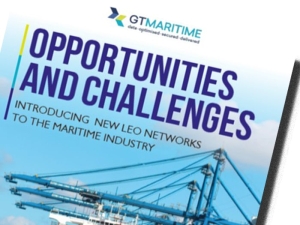


(Posted on 09/08/23)
GTMaritime, leading experts in secure maritime data communications solutions, has released a new whitepaper that assesses the impact Low Earth Orbit (LEO) networks are having on the maritime industry and key considerations for wider adoption.
Available to download free of charge, Opportunities and Challenges: Introducing New LEO Networks to the Maritime Industry, offers an insightful overview of commercial shipping’s first movers in LEO network service use. It outlines the potential for positive impact of LEO network bandwidth on vessel operations and describes a “quantum leap for crew connectivity possibilities”.
However, the thoughtful paper also explores the challenges of integrating LEO network services that do not offer global coverage into shipping’s existing global connectivity infrastructure. In a tightly regulated industry, it also gives due consideration to the fact that existing networks support mandatory GMDSS connectivity.
Richard White, Global Commercial Director at GTMaritime, said: “The introduction of LEO networks is a massive step forward for maritime communications and connectivity. The expectations are understandably high, as is the interest around how the addition of these constellations could transform maritime communications for the better. However, it’s important to recognise that LEO networks on their own would struggle to sustain the communication demands of modern shipping and that a more realistic approach focusing on integration with current infrastructure and solutions is required.”
Key sections of the new whitepaper consider the connectivity and cyber security imperatives, if LEO networks are to be integrated with existing solutions, highlighting how vessels must have systems in place to prevent disruption when switching between satellites or providers. The paper concludes with specific questions that need answering when considering the use of LEO networks and offers guidance on issues including the risks of bandwidth reduction and the benefits of data compression.
“Our new whitepaper offers insights into the challenges and opportunities faced by owners and operators as they assess whether and how to use LEO networks as part of their ship-to-shore connectivity. To help them in their considerations, it provides straightforward guidance on the critical issues affecting ship operations, crew connectivity and systems interoperability,” added Richard.
Rio Tinto’s first Pilbara-made iron ore rail car has rolled off the production line in Karratha... Read more
Precision meets progress at Phu My Port, Vietnam. The LPS 550 has been deployed to handle bulk commodities... Read more
bound4blue, a global leader in wind propulsion systems, has expanded its industrial footprint in Asia... Read more
As the industry explores multiple decarbonisation pathways, methanol is gaining attention as a practical... Read more
Technology group Wärtsilä will supply an integrated hybrid propulsion system for a bulk carrier... Read more
Superior Industries, Inc., a US-based manufacturer and global supplier of bulk material processing and... Read more
ESL Shipping has taken a significant step forward in digitalisation by deploying a new multichannel... Read more
Condition Monitoring Technologies (CMT) has deepened its presence across Asia’s most influential... Read more
After delivering its first full-scale seagoing project last week, Wattlab signed a contract at Europort... Read more
Steelpaint GmbH has reported strong growth in orders for corrosion protection coatings on Germany&rsquo... Read more